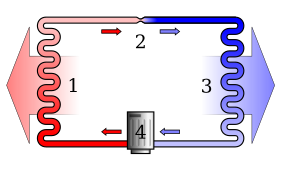Not the system the Sun. There are so many Solar Water Heaters available now that it is embarressing. Anyone who owns their own home and doesn’t install one is an Energy Hog. Tankless water heater owners are given a pass.
http://en.wikipedia.org/wiki/Solar_hot_water
Solar hot water
Solar Hot Water refers to water heated by solar energy. Solar heating systems are generally composed of solar thermal collectors, a fluid system to move the heat from the collector to its point of usage, and a reservoir or tank for heat storage and subsequent use. The systems may be used to heat water for home or business use, for swimming pools, underfloor heating or as an energy input for space heating and cooling and industrial applications.
In many climates, a solar heating system can provide a very high percentage (50% to 75%) of domestic hot water energy. In many northern European countries, combined hot water and space heating systems (solar combisystems) are used to provide 15 to 25% of home heating energy.
In the southern regions of Africa like Zimbabwe, solar water heaters have been gaining popularity, thanks to the Austrian and other EU funded projects that are promoting more environmentally friendly water heating solutions.
Residential solar thermal installations can be subdivided into two kinds of systems: compact and pumped systems. Both typically include an auxiliary energy source (electric heating element or connection to a gas or fuel oil central heating system) that is activated when the water in the tank falls below a minimum temperature setting such as 50 °C. Hence, hot water is always available. The combination of solar hot water heating and using the back-up heat from a wood stove chimney to heat water[2] can enable a hot water system to work all year round in northern climates without the supplemental heat requirement of a solar hot water system being met with fossil fuels or electricity.
Evacuated tube collector
Evacuated tube collectors are made of a series of modular tubes, mounted in parallel, whose number can be added to or reduced as hot water delivery needs change. This type of collector consists of rows of parallel transparent glass tubes, each of which contains an absorber tube (in place of the absorber plate to which metal tubes are attached in a flat-plate collector). The tubes are covered with a special light-modulating coating. In an evacuated tube collector, sunlight passing through an outer glass tube heats the absorber tube contained within it. The absorber can either consist of copper (glass-metal) or specially-coated glass tubing (glass-glass). The glass-metal evacuated tubes are typically sealed at the manifold end, and the absorber is actually sealed in the vacuum, thus the fact that the absorber and heat pipe are dissimilar metals creates no corrosion problems. The better quality systems use foam insulation in the manifold. low iron glass is used in the higher quality evacuated tubes manufacture.
Lower quality evacuated tube systems use the glass coated absorber. Due to the extreme temperature difference of the glass under stagnation temperatures, the glass sometimes shatters. The glass is a lower quality boron silicate material and the aluminum absorber and copper heat pipe are slid down inside the open top end of the tube. Moisture entering the manifold around the sheet metal casing is eventually absorbed by the glass fibre insulation and then finds its way down into the tubes. This leads to corrosion at the absorber/heat pipe interface area, also freeze ruptures of the tube itself if the tube fills sufficiently with water.
Two types of tube collectors are distinguished by their heat transfer method: the simplest pumps a heat transfer fluid (water or antifreeze) through a U-shaped copper tube placed in each of the glass collector tubes. The second type uses a sealed heat pipe that contains a liquid that vapourises as it is heated. The vapour rises to a heat-transfer bulb that is positioned outside the collector tube in a pipe through which a second heat transfer liquid (the water or antifreeze) is pumped. For both types, the heated liquid then circulates through a heat exchanger and gives off its heat to water that is stored in a storage tank (which itself may be kept warm partially by sunlight). Evacuated tube collectors heat to higher temperatures, with some models providing considerably more solar yield per square metre than flat panels. However, they are more expensive and fragile than flat panels. The high stagnation temperatures can cause antifreeze to break down, so careful consideration must be used if selecting this type of system in temperate climates.
For a given absorber area, evacuated tubes can maintain their efficiency over a wide range of ambient temperatures and heating requirements. The absorber area only occupied about 50% of the collector panel on early designs, however this has changed as the technology has advanced to maximize the absorption area. In extremely hot climates, flat-plate collectors will generally be a more cost-effective solution than evacuated tubes. When employed in arrays of 20 to 30 or more, the efficient but costly evacuated tube collectors have net benefit in winter and also give real advantage in the summer months. They are well suited to extremely cold ambient temperatures and work well in situations of consistently low-light. They are also used in industrial applications, where high water temperatures or steam need to be generated. Properly designed evacuated tubes have a life expectancy of over 25 years which greatly adds to their value.
Or you could make your own:
www.motherearthnews.com/Renewable-Energy/
This is what the Chinese buy:
Or you could Pay Alot for it:
There is a lot out there:
www.firemountainsolar.com/solarhotwater.html
www.honglesolar.com/SolarWaterHeater.htm
http://talensun.com/procuct.asp
www.toolbase.org/Technology-Inventory/
www.builditsolar.com/Projects/
:}
:}










